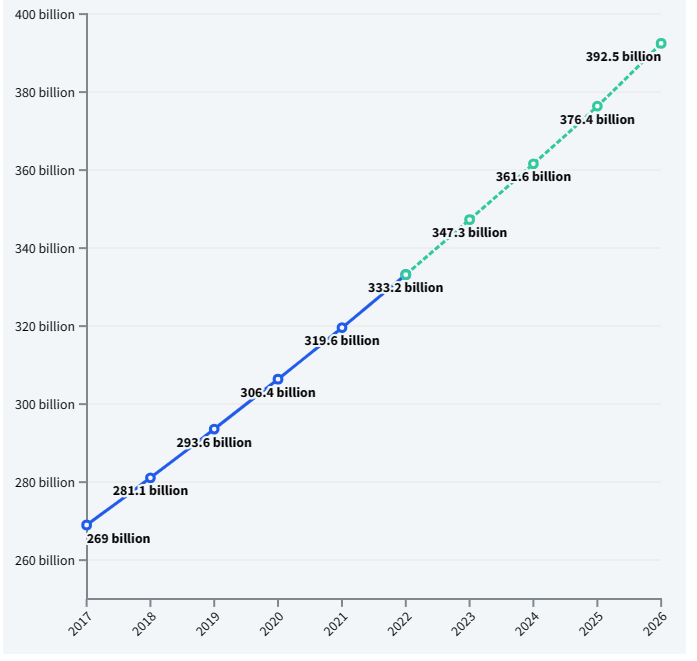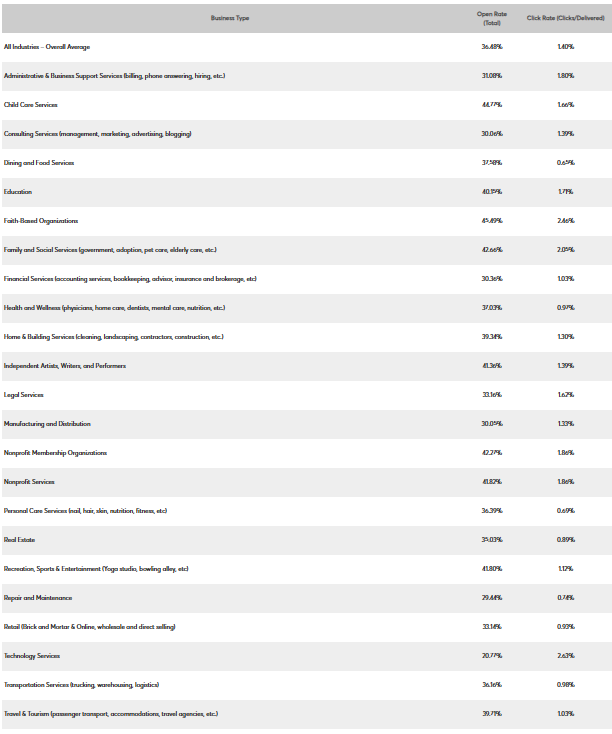
Think about the last time you wrote a marketing email promoting your company’s offerings. Maybe you spent a few hours crafting the perfect email copy and call to action (CTA). You hit the send button and waited for a flood of website traffic and phone calls, but nothing happened. The frustration was real. What must you do to get the traction your organization deserves?
Ultimately, email marketing is a fine art. Anticipating customer needs and aligning them with your business objectives is just one part of the equation. Other factors include compelling copy, technical insight, and analytics.
Email marketing conversion rate is one metric used to gauge a campaign’s effectiveness. Your conversion rate indicates the percentage or number of people who took a desired action after reading your email. The action can be anything — a visit to your website, an appointment booking, or a sale. The higher your conversion rate, the better your campaign’s performance.
According to Statista, the average conversion rate for email marketing hovers around 3%, but that can vary significantly by several factors, including your industry, messaging content, and location. While averages can help you set your expectations, you may find it advantageous to establish your own benchmarks as you refine your marketing campaign strategy.
Email conversion rate calculations
The conversion rate formula in email marketing identifies how many people take action on your message. Here’s how to use it and what metrics to consider when evaluating your performance.
How to calculate email conversion rate
To determine your email marketing conversion rate, start by identifying the action you want people to take from your email. That might be clicking on your website, replying with a message, following your socials, scheduling an appointment, or purchasing a product or service. Then, add all the successful conversions generated from your email. The result is your total conversions.
Next, tally the number of emails delivered successfully to your subscribers. You’ll divide the total conversions by the number of delivered emails and multiply the result by 100 to obtain your conversion rate.
For instance, say you send out 1,000 emails, and 990 reach your subscriber’s inbox. Of the delivered emails, 45 recipients convert by visiting your website. Your email marketing conversion rate is 4.5%, or (45/990) x 100.
Understanding open rate, click-through, and bounce rates
You can use several email marketing metrics to analyze campaign performance, including open rate, click-through, and bounce rates. Each metric measures different aspects of the campaign.
- Open rate: The number or percentage of people who open an email in a single email campaign.
- Click-through rate: Percentage of people who click on your CTA link within your email.
- Bounce rate: Percentage of undelivered emails in a campaign.
Reviewing various metrics provides a comprehensive overview of your campaign’s performance.
Average email conversion rates by campaign type
According to Statista, conversion rates can vary by the email’s purpose. Welcome emails average a 3% conversion rate, while abandoned cart emails average a 2.39% rate.
Average email conversion rate statistics over time
Constant Contact measures various email metrics monthly across all our clients, which amounts to over 200 million emails monthly. You can find industry-specific averages for opens, clicks, and bounces on the Constant Contact Knowledge Base.
Other data shows that the number of emails sent annually continues to grow exponentially. By 2026, email usage will be nearly double that of 2016:

Common email conversion rate challenges and how to address them
It’s pretty common for marketers to encounter lower email marketing conversion rates than expected. Here are a few reasons for lower conversion rates and what you can do to overcome them.
Email landing in spam folder
Sometimes, email service providers automatically direct your messages to the recipient’s spam folder. Using spammy language like “Too good to be true,” “Earn unlimited passive income,” or “Free gift just for you” can trigger a service provider’s spam filter. Other factors, like subscribers reporting prior messages as spam, can increase the risk.
To minimize your chances of ending up in spam and your customers not reading your messages, ask your subscribers to add your email address to their contacts list. Also, focus on creating genuine messages that resonate with your audience.
Unsubscribe issues
No matter how engaging and valuable your emails are, occasionally, people will unsubscribe. That’s just a part of marketing — sometimes, customers move on because they no longer need your services. Or, they’re attempting to cut the number of sales emails they receive daily.
To limit your unsubscribe rates, make each email interaction count. The more clients enjoy your content, the more likely they will remain on your subscriber list. A robust segmentation and targeting strategy can help you connect with subscribers based on their interests and demographics.
Mobile optimization
You can’t control where your subscribers open your email. Some read it on their smartphone, while others use a PC, laptop, or tablet. Ensure subscribers can act on your email no matter where they read it. Otherwise, you risk losing them to poor user experience (UX).
Most email marketing software platforms include mobile and PC optimization features — including Constant Contact.
Email marketing ROI
Whenever you try a new marketing strategy, it helps to evaluate its profitability. One way to do so is by assessing your email marketing return on investment (ROI).
How to calculate email marketing ROI
To calculate your email marketing ROI, simply follow this formula:
[(Email marketing profit – email marketing cost) / Email marketing cost] x 100 = Email marketing ROI
So, say you sent an email to subscribers to advertise a new product. You generated $1,000 in sales on the product, and the cost to write, develop, and send your email was $600. Your ROI is 66.67%, or [($1,000 – $600) / $600] x 100 = 66.67%.
Revenue generated per email
To calculate the revenue generated per email, consider using a unique referrer link. That way, you can determine whether a sale occurred directly from your message or another source.
Improving campaign results to boost ROI
You can use various techniques to enhance your email marketing campaign results. Segmentation, A/B testing, and personalization strategies can all boost open rates and generate higher revenues and ROI.
Other email marketing ROI statistics
On average, one dollar spent on email marketing generates $36 in profitability. Certain industry sectors, including retail and e-commerce, tend to see higher ROIs.
Benchmarking your email campaigns
Are you curious to see how your organization’s email campaigns stack up against others? Take a look at Constant Contact’s recent analysis of open and click-through rates across different sectors.

If your open and click-through rates are close to the averages for your industry, consider your campaign successful! If not, you might benefit from some tweaks to your marketing strategy.
Tips to double email marketing conversion rate
There’s always room for improvement in your email marketing strategy. Here’s how to increase conversion rate in email marketing.
1. List pruning and segmentation
Sometimes, your emails bounce back or don’t deliver. Instead of holding on to an invalid email address, consider removing it from your subscriber list. That way, undelivered messages don’t skew your conversion rates.
You can also consider segmenting your emails to better target subscriber interest. The more relevant content you provide recipients, the more likely they are to read it — and take action!
2. Email frequency optimization
Sending emails too often — or not often enough — can hurt your conversion rates. Test out different sending times and frequencies to find the sweet spot for your organization.
3. Creating mobile-friendly emails
These days, many consumers read emails on their mobile devices, not a PC. Optimize your emails for mobile devices like smartphones and tablets to make the most out of your messaging.
4. Crafting powerful subject lines and CTA
Your subscribers may receive dozens of emails each day. To ensure yours stands out, work on writing unique subject lines that speak to your subscriber’s needs or interests. Ensure your CTA is clearly visible so they know how to take action if they decide to.
5. Utilizing dedicated landing pages
You can create dedicated landing pages that link directly from your email. A dedicated page is great for tracking email performance and minimizes the work your subscribers need to do to take action.
6. A/B testing for email campaigns
A/B testing allows you to test different text, images, CTAs, and other factors to see how they impact click-to-open rates and conversions. Sometimes, slightly different messaging can improve your campaign results.
7. Effective email management
A comprehensive customer relationship management (CRM) or email marketing platform can help you manage your subscriber list and oversee your campaign performance.
8. Automated drip campaigns
A drip campaign helps you build momentum and familiarity with new subscribers. You can sequence your campaign into multiple automated emails, allowing customers to learn more about your brand and offerings.
Audience segmentation and personalization
Most companies find they have a variety of customers, all with various interests and needs. By segmenting your emails across different demographics, geographies, and other factors, you’ll find it easier to develop relevant content for your readers. You may see conversions increase, too!
Some brands find that personalizing content based on a user’s stage in the customer journey brings results. For instance, you might recommend specific products based on their browsing or purchase history or send them a video product demonstration if they’re new to your company.
Advanced tips and considerations
As you become more comfortable with email marketing, consider these tips:
Understand what causes low email conversion rates
A few factors that can hurt your conversion rates include:
- Sending emails too frequently
- Not personalizing messages
- Lack of segmentation strategy
- Not optimizing emails for mobile devices
If you aren’t getting the conversion rates you’re hoping for, look closely at your campaign to see where you can improve.
Maintain good email etiquette and best practices
When emailing a subscriber, keep it friendly and professional. If a subscriber reaches out directly, try to respond quickly to their questions. And always honor any client’s request to unsubscribe.
Create campaigns for different sectors
Not every email campaign has to be sales-oriented. You can create campaigns for various purposes, including relationship development, establishing credibility, sales, and services you offer.
Email marketing tools and software
Consider investing in email marketing tools and software to add value to your campaign and help you monitor your results.
Marketing software tools like Constant Contact include features like tracking email analytics, and customer relationship management. Constant Contact also contains email marketing automation features, which you can use to schedule messages or create drip campaigns.
Use your email marketing conversion rate to measure success
Knowing your email marketing conversion rate — and comparing it to your own benchmarks or industry metrics — helps you analyze your campaign’s effectiveness. If you find your conversion rate isn’t quite meeting your expectations, try identifying ways to improve results. A few ideas include segmentation, personalization, and automated drip campaigns.
To learn more, check out Constant Contact’s comprehensive guide to email marketing and sign up for our Hints & Tips newsletter.




